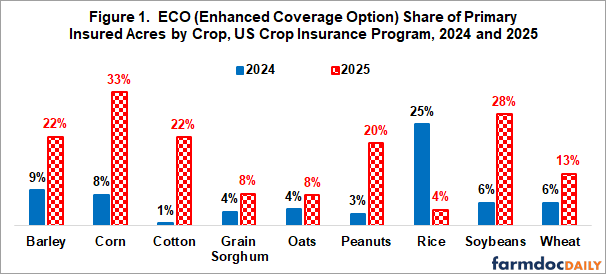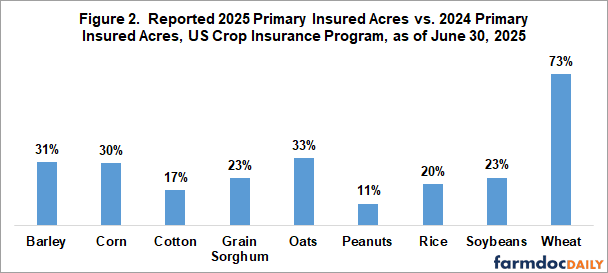Response to the Increase in 2025 Crop ECO Premium Subsidy
Although early in the reporting period for 2025 crop insurance decisions by farmers, use of ECO (Enhanced Coverage Option) insurance has tripled vs 2024. The key change from 2024 is an increase in ECO premium subsidy implemented by USDA, RMA (US Department of Agriculture, Risk Management Agency). ECO subsidy rate is now 65% compared to the prior rates of 44% when ECO was combined with individual farm revenue coverage and 51% when combined with individual farm yield coverage. The tripling in use of ECO provides insights into the likely response to the proposed increase in the premium subsidy rate for SCO (Supplemental Coverage Option) insurance from 65% to 80% in both the House and Senate Reconciliation Farm Bills.
Area Add-Up Insurance
Three area add-up insurance products are discussed in this article: ECO (Enhanced Coverage Option), SCO (Supplemental Coverage Option), and STAX (Stacked Income Protection Plan). ECO coverage is either 95% or 90% of an area revenue or yield policy down to 86%, the coverage level of SCO. ECO can be purchased without buying SCO, and vice versa. Acres in ECO can be in either the ARC (Agriculture Risk Coverage) or PLC (Price Loss Coverage) farm commodity programs. For further discussion of ECO, see the February 11, 2025 farmdoc daily.
SCO provides coverage on area yield or revenue loss. SCO coverage is from 86% down to the coverage level elected by a farmer for an underlying, individual farm insurance product. For example, if a farmer chose 80% RP (Revenue Protection), SCO would cover from 80% to 86% of a comparable area based revenue product. An individual farm insurance product must be bought to be able to buy SCO. Acres in SCO can be in PLC, but not ARC. For further discussion of SCO, see the February 18, 2025 farmdoc daily.
STAX (Stacked Income Protection Plan) is available only for cotton. Coverage of area revenue loss is from 90% down to the coverage level a farmer elects for another insurance product, but no longer than 70%. STAX can be purchased alone, with coverage from 90% down to an elected level that can be no lower than 70%. Acres in STAX are ineligible for both ARC and PLC. STAX’s premium subsidy is 80%. For further discussion of STAX, see the January 2024 Fact Sheet from USDA, RMA.
ECO Acreage Response
As of June 30, 2025, the share of ECO on primary insured acres for 2025 was at least double the 2024 crop year share for all but one of the nine large acreage US field crops in Figure 1. The exception is rice. For the nine crops combined, ECO share has more than tripled from 6% (2024) to 23% (2025). For corn, soybeans, cotton, and peanuts; ECO use has increased by more than 15 percentage points.
The large increase in ECO use for cotton is likely related to the ability to enroll ECO acres in commodity programs, especially PLC (Price Loss Coverage), the program most commonly selected for cotton. In contrast, acres in STAX cannot be enrolled in commodity programs. STAX’s share of primary insured cotton acres is currently 20% for 2025 vs. 54% for 2024, signaling the expected switch to ECO with PLC. Both the House and Senate Reconciliation Farm Bill increase PLC reference prices, increasing the attractiveness of SCO over ECO.
As a share of 2024 primary insured acres, 2025 primary insured acres reported as of June 30, 2025 vary from 11% for peanuts to 73% for wheat (see Figure 2). The share for wheat is much higher because insurance decisions for winter wheat harvested in 2025 were due by the end of September 2024. Winter wheat has accounted for over 70% of total US wheat acres in recent years (USDA, National Agricultural Statistics Service).
Policy Discussion
Raising the percent premium subsidy rate for a crop insurance product reduces the farmer-paid premium and thus is expected to increase use of the product. Early data for 2025 crops confirm this expected hypothesis. So far, the higher ECO premium subsidy of 65% is associated with a tripling in ECO use for nine large acreage US field crops as a group.
The notable 2024-to-2025 increase in ECO use suggests the following likely implications if the SCO premium subsidy rate is increased to 80%.
- The increase in use of SCO should be at least as much as the 2024-to-2025 increase in ECO use given that SCO would have a higher subsidy rate (80% vs. 70%). SCO coverage level is also being increased from 86% to 90%. Moreover, both SCO and ECO, as area insurance products, are excluded from the “commission cap” and thus are attractive for agents to sell compared with individual farm insurance. Federal spending on SCO should increase notably.
- An ECO coverage range of 95-90% will be created. The notable increase in ECO use in 2025 suggests sizable demand exists for 95% ECO coverage at a 70% premium subsidy rate. Moreover, following the normal adoption path of a new product, total Federal spending on ECO would be expected to grow as familiarity with the product and its subsidy rate grows.
- Use of cotton STAX is expected to decline. STAX precludes enrollment in commodity programs while SCO allows enrollment in PLC, the commodity program most chosen for cotton. Federal spending on PLC is expected to increase, partly offset by lower spending on STAX.
- In summary, spending on premium subsidies for area add-up insurance is likely to grow notably over the next farm bill period if the proposed changes in SCO insurance are enacted.
Increasing subsidy rates for SCO (and ECO) are unlikely to address the disparity in crop insurance performance across program crops (see, for example, June 10, 2025 and June 12, 2025 farmdoc daily). Higher subsidies do not alter current crop insurance methodologies that have resulted in notably higher insurance payments net of farm-paid premiums to more risky crop production areas.
Taking a broader perspective, Congress may be moving toward consolidating current area add-up insurance products into a streamlined set of products similar to the consolidation of individual farm insurance products into what are termed the “combo” products that were implemented starting with the 2011 crop year.
References
Paulson, N., G. Schnitkey, and C. Zulauf. February 18, 2025. Should SCO Impact Your Decision to use ARC-CO for 2025? farmdoc daily (15):31. Department of Agricultural and Consumer Economics, University of Illinois at Urbana-Champaign. http://www.farmdoc.illinois.edu/
Schnitkey, G., N. Paulson, and C. Zulauf. Enhanced Coverage Option for 2025. February 11, 2025. farmdoc daily (15):26. Department of Agricultural and Consumer Economics, University of Illinois at Urbana-Champaign. February 11, 2025. http://www.farmdoc.illinois.edu/
Schnitkey, G., B. Sherrick, C. Zulauf, N. Paulson, and J. Coppess. June 10, 2025. The House Reconciliation Bill Proposal for SCO: Income Support for High Risk Farmland. farmdoc daily (15):106. http://www.farmdoc.illinois.edu/
US Department of Agriculture, National Agricultural Statistics Service. June 2025. QuickStats. http://quickstats.nass.U.S.da.gov/
US Department of Agriculture, Risk Management Agency. July 29, 2024. USDA Announces Changes to Enhanced Coverage Option Insurance Program. News Release. https://www.rma.usda.gov/news-events/news/2024/washington-dc/usda-announces-changes-enhanced-coverage-option-insurance
US Department of Agriculture, Risk Management Agency. June 2025. Summary of Business. http://www.rma.usda.gov
US Department of Agriculture, Risk Management Agency. Revised January 2024. Stacked Income Protection Plan (STAX) for Upland Cotton. Fact Sheet. https://www.rma.usda.gov/sites/default/files/2024-02/STAX-Upland-Cotton-Fact-Sheet.pdf
Zulauf, C., G. Schnitkey, J. Coppess, and N. Paulson. June 12, 2025. Crop Insurance, Premium Subsidies, and Soybean-Corn Disparity. farmdoc daily (15):108. Department of Agricultural and Consumer Economics, University of Illinois at Urbana-Champaign. http://www.farmdoc.illinois.edu/
Disclaimer: We request all readers, electronic media and others follow our citation guidelines when re-posting articles from farmdoc daily. Guidelines are available here. The farmdoc daily website falls under University of Illinois copyright and intellectual property rights. For a detailed statement, please see the University of Illinois Copyright Information and Policies here.









